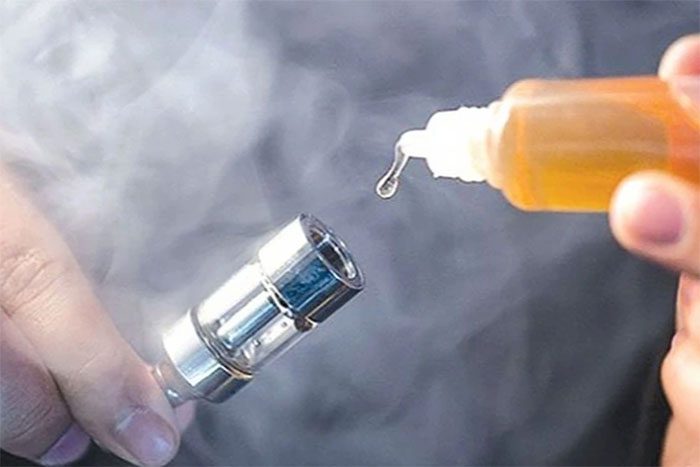According to statistics from the Ministry of Public Security, there are currently nearly 240,000 registered drug addicts in the country, the majority of whom are young people, accounting for about 60% of first-time users aged between 15 and 25 years old.
Teenagers as Young as 13 Using Drugs
In recent years, the drug problem in Vietnam has become increasingly complex, with a wider variety of new and sophisticated drugs emerging.
Worryingly, among these, synthetic drug users account for 70-75%, with the rate of users of crystal meth and other stimulants rising significantly.
At a seminar titled “Preventing New Forms of Drugs,” organized by Dan Tri newspaper, Lieutenant Colonel Phan Dang Trung, Deputy Head of Department 6, Drug Crime Investigation Police Department, Ministry of Public Security, noted that there are many changes in drug usage trends.

Lieutenant Colonel Phan Dang Trung, Deputy Head of Department 6, Drug Crime Investigation Police Department, Ministry of Public Security (Photo: Manh Quan).
New Trends in Drug Types
Compared to the past, drug users are shifting towards new types of drugs, moving away from traditional opiate-based drugs (collectively referred to as the Opiate group) such as heroin, morphine, codeine, pethidine, and buprenorphine.
Currently, about 80-90% have transitioned to synthetic drugs—that is, drugs synthesized from various chemicals (known as precursors). Examples include amphetamines, MDMA, ecstasy, crystal meth, LSD (also known as tongue drug), ecstasy pills, and cannabis… or a combination of both opiate-derived drugs and synthetic drugs.
A newly discovered and relatively common tactic is that some individuals are soaking food, beverages, and electronic cigarettes with drugs… and organizing sales on social media platforms.
“Through cases we have discovered, drugs are disguised as various goods mentioned above, mostly synthetic drugs, cannabis oils, and even some very new substances not yet listed among the drugs and precursors regulated by the government,” Trung stated.
Demographics and Age Groups
Current drug addicts and illegal drug users come from diverse backgrounds, including officials, civil servants, workers, farmers, students, and those employed as well as unemployed.
“More dangerously, the trend of addiction and illegal drug use is increasingly affecting younger individuals. Statistics show that about 60% of first-time drug users are aged 15-25, including many as young as 13-15 years old.”
Among the total 95% of synthetic drug users, 70-75% are aged 17-35, with a significant proportion being youth, students, and scholars,” Trung reported.
The Most Dangerous Drug: Hidden in Electronic Cigarettes
According to Dr. Nguyen Trung Nguyen, Director of the Poison Control Center at Bach Mai Hospital, there are currently many different types of drugs. Notably, many new drugs are very difficult to detect and can be hidden in food, beverages, electronic cigarettes… posing many challenges in drug prevention efforts.

Dr. Nguyen Trung Nguyen, Director of the Poison Control Center, Bach Mai Hospital (Photo: Manh Quan).
Among the new drugs, according to Dr. Nguyen, synthetic cannabis is the most dangerous when considering multiple aspects.
“This group includes many different chemicals. With just a few chemical reactions, malicious actors can create a new compound. The number of these chemicals always exceeds the banned lists of all countries,” Dr. Nguyen explained.
According to this expert, there are currently several hundred synthetic cannabis substances. The testing capacity of all countries cannot cover detection of all.

Synthetic cannabis can be hidden in electronic cigarettes (Photo: Getty).
To test a substance, a top national laboratory with highly complex and specialized equipment is required, which is costly and needs many highly skilled personnel, taking many days or even months to detect a substance.
Notably, Dr. Nguyen indicated that synthetic cannabis is often very cleverly disguised. From clinical observations, he noted that this type of drug can be contained within electronic cigarettes or soaked into various herbal materials, commonly referred to as “grass.”
In general, all types of drugs are substances that have strong effects on the nervous and mental systems, causing distorted perceptions and thoughts about the surrounding environment (also known as hallucinations).
“These are strong stimulants that can damage various organs. The information regarding their characteristics and addictive effects is very complex,” Dr. Nguyen confirmed.
Signs of Drug Addiction
According to Dr. Nguyen, early detection of drug use for intervention is particularly important.
This can be accomplished by observing changes in habits, daily activities, and behaviors.
Drug addicts will often have irregular schedules, for example, frequently returning home late or being absent without clear reasons, and showing a tendency to frequent entertainment venues (nightclubs, dance floors, late-night gatherings with friends, parties…) more often.
Additionally, the clothing and appearance of drug addicts may be noticeably different from others.
“Addicts may show mild intoxication symptoms or other signs related to drug effects, especially shortly after use, such as excessive excitement, unusual speech content, and may still exhibit hallucinations, trembling, or sweating,” Dr. Nguyen added.
Furthermore, addicts may experience financial issues, such as frequently borrowing money.
Addicts also tend to feel anxious, worried, or avoid situations where someone might check their private areas (such as rooms, bags, or wallets), or encounters with law enforcement.
Many Solutions Being Implemented to Combat Drugs
According to Trung, the Party, State, various ministries, localities, and the entire population have implemented numerous solutions to combat the drug problem, especially the trend of new drugs, focusing on key content:
1. Reducing Supply: Strengthening efforts to combat drug trafficking, preventing drugs from being smuggled from abroad into the country; ensuring Vietnam does not become a major production, collection, transit, or consumption area for drugs, nor a base for drug criminal activities.
2. Reducing Demand: Focusing on preventive education, implementing social prevention measures (raising awareness, improving cultural life for the people, especially high-risk groups, particularly students). The goal is to prevent an increase in the number of addicts and illegal drug users—essentially “reducing demand” for drugs.
3. Reducing Harm: For individuals already addicted or using illegal drugs, effective rehabilitation measures are implemented to prevent relapse after returning to the community; effectively managing illegal drug users to prevent continued use leading to addiction, in accordance with the Drug Prevention and Control Law.


















































